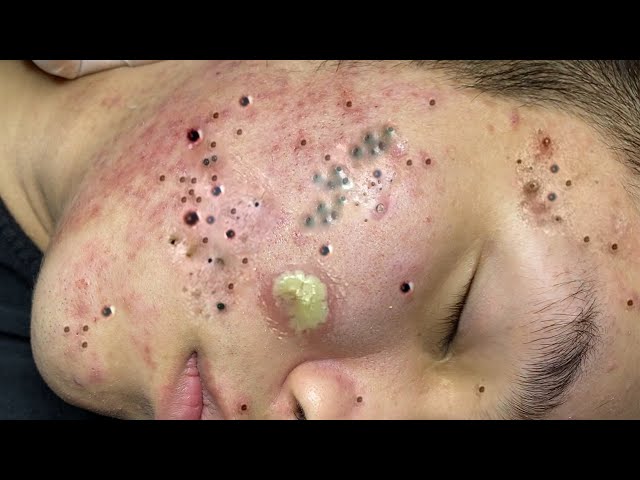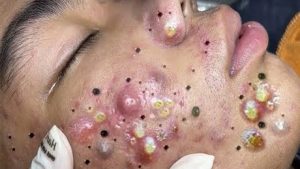
Big pimples before
Big pimples before
Please scroll down to watch the video.👇👇
It sounds like you’re asking how to deal with big pimples before they fully form or become worse. Here are some effective steps to treat big pimples early, especially if you feel them coming under the skin (like those painful cystic pimples):
🔍 1. Catch It Early (As Soon As You Feel It!)
If you feel a painful bump forming under your skin, that’s your chance to act early.
💨 2. Apply a Cold Compress (Right Away)
-
Use ice wrapped in a clean cloth.
-
Apply for 5–10 minutes on and off to reduce swelling and redness.
💊 3. Spot Treat With These:
-
Benzoyl Peroxide (2.5%–5%) – kills acne-causing bacteria.
-
Salicylic Acid – helps unclog pores and reduce swelling.
-
Hydrocortisone Cream (short-term use) – helps reduce inflammation.
Apply once or twice a day directly on the pimple.
🧪 4. Try a Sulfur or Clay Mask
-
Use overnight or for 10–15 minutes on the area.
-
Helps dry up the oil and bring the pimple to a head faster.
🛑 5. Don’t Squeeze It
-
Popping a big pimple before it’s ready can push bacteria deeper, cause scarring, or make it worse.
💤 6. Overnight Pimple Patches (Hydrocolloid)
-
These draw out pus and flatten pimples while you sleep.
-
Best for surface pimples or ones that are almost ready.
☎️ 7. For Big Cystic Pimples:
If you often get large, painful pimples under the skin, ask your doctor about:
-
Cortisone injections (fastest way to flatten)
-
Prescription topicals like tretinoin or clindamycin
-
Oral meds like antibiotics, spironolactone, or Accutane (for severe cases)

To effectively manage large pimples, especially cystic acne, early intervention is crucial. Here’s a detailed guide with evidence-based treatments and references:
🧊 1. Apply Ice to Reduce Inflammation
Applying ice can decrease swelling, redness, and pain associated with cystic acne. Wrap an ice cube in a clean cloth and apply it to the affected area for 5–10 minutes, several times a day. Healthline
💊 2. Use Topical Treatments with Proven Ingredients
Benzoyl Peroxide
Benzoyl peroxide is effective in killing acne-causing bacteria, removing excess oil, and exfoliating dead skin cells. Over-the-counter products are available in strengths from 2.5% to 10%. Starting with a lower concentration can minimize potential skin irritation. Mayo Clinic+1PMC+1
Salicylic Acid
Salicylic acid, a beta hydroxy acid, helps unclog pores and reduce inflammation. It’s particularly effective for blackheads and whiteheads. However, it may not be as effective for severe acne compared to benzoyl peroxide. Medical News Today
🧴 3. Consider Hydrocortisone Cream for Inflammation
Topical hydrocortisone can reduce redness and swelling in inflammatory acne lesions. However, it doesn’t address acne-causing bacteria and should not be used as a standalone treatment. Short-term use, in combination with other treatments, may be beneficial. WebMD+2Medical News Today+2Acne.org+2
🚫 4. Avoid Popping or Squeezing Pimples
Manipulating pimples can push bacteria deeper into the skin, increasing inflammation and the risk of scarring. It’s best to let pimples heal naturally or seek professional treatment.
🩹 5. Use Hydrocolloid Patches
Hydrocolloid patches can help absorb excess fluid and protect the pimple from external irritants, promoting faster healing. They’re most effective on surface-level pimples.
🩺 6. Consult a Dermatologist for Persistent or Severe Acne
If over-the-counter treatments aren’t effective, a dermatologist may recommend:
-
Topical Retinoids: Help unclog pores and reduce inflammation.
-
Oral Antibiotics: Reduce bacteria and inflammation. WebMD+1Real Simple+1
-
Hormonal Treatments: Such as birth control pills or spironolactone for women. Aurora Health Care
-
Isotretinoin (Accutane): For severe, treatment-resistant acne.
📝 Summary
Early intervention with appropriate topical treatments can effectively manage large pimples. Avoiding manipulation of pimples and consulting a dermatologist for persistent cases are key steps in preventing complications and achieving clearer skin.
-
Leave a Reply